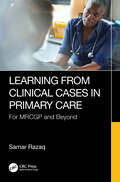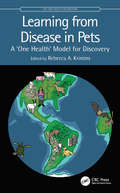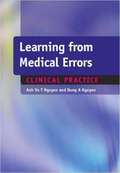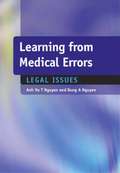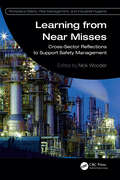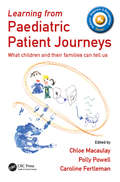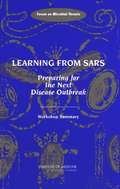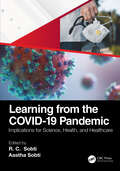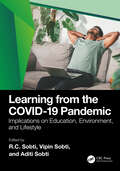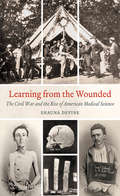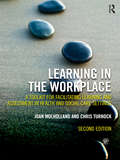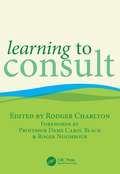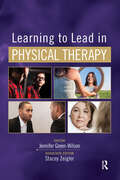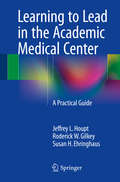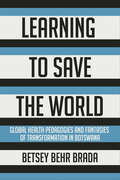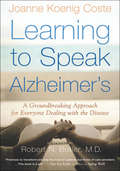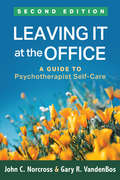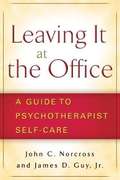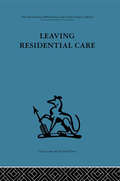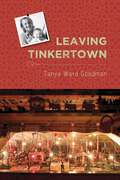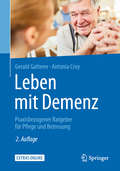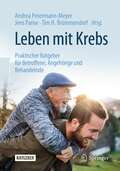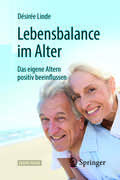- Table View
- List View
Learning from Clinical Cases in Primary Care: For MRCGP and Beyond
by Samar RazaqThis new book is designed around 20 clinical cases, each representative of scenarios encountered by doctors who work in primary care and which will prompt learning in related issues surrounding each clinical scenario. Each case description concludes with an initial exam style question which MRCGP candidates will recognize as being directed towards learning for the Applied Knowledge Test (AKT). An expanded answer to that initial question is followed by a detailed explanation, concluding with further questions for self-assessment and reflection.The cases also provide a template for the preparation of the Simulated Consultation Assessment (SCA) component of the MRCGP exam and can be used by trainers and trainees alike as a prototype for role play. Some cases offer learning opportunities through discussion of discrete clinical entities, whilst others use the clinical cases to introduce the reader to broader concepts which often need grappling with in primary care.Key Features: True-to-life problems illustrate the complex interplay between patient and doctor in the consultation process Content reflects the natural variation in disease presentation, not just from patient to patient but in the same patient at different times Text is interspersed with bullet points and important tips to aid the learning process Multiple choice questions expand knowledge around inter-related topics and provide further invaluable preparation for the AKT and SCA Covering the wide range of specialities that are encountered in primary care, the book reflects the remarkable breadth of clinical knowledge that is required of a primary care practitioner and demonstrates why general practice remains a challenging but rewarding specialty to master.
Learning from Disease in Pets: A ‘One Health’ Model for Discovery (CRC One Health One Welfare)
by Rebecca A. KriminsLearning from Disease in Pets: A ‘One Health’ Model for Discovery is the first encompassing reference guide for veterinarians, researchers and physicians on conducting studies using spontaneous models of disease in animals. The study of naturally occurring disease in (pet) animals can help model our understanding of the biology, prevention and therapy of human and animal diseases. Studies of pet dogs, for instance, can aid treatment of complex medical problems such as cancer, orthopedic, cardiopulmonary, and neuro-inflammatory diseases, and zoonotic infections. Each chapter within this novel cross-species approach is contributed by a leader, or leaders, in their field of research. Using clinical trials to learn how pets with real diseases respond to therapy can lead to breakthroughs in human medicine, as well as benefiting pets suffering from otherwise debilitating illness. Despite similarities of diseases across species, there are very few spontaneous models of disease used in research compared with models where disease is induced in healthy laboratory animals. Many medical researchers and veterinarians have a multitude of questions regarding how to use naturally occurring diseases in pets for the discovery of treatments and diagnostics: this book will demonstrate how to safely make this happen. This book encourages veterinarians to build on and disseminate existing findings for the wider benefit of pets and humans. Many pets suffering from incurable illnesses may benefit from clinical trials; the book includes a section on the imperative communication styles necessary within the research environment and with clients, a compelling discussion on the ethics of using pets in veterinary clinical research, comprehensive tables of diseases that spontaneously occur in animals and humans, the regulatory requirements necessary to move therapy from benchside research to patient bedside, as well as intricate details on how to design a robust clinical study.
Learning from Medical Errors: Clinical Problems
by Anh Vu Nguyen Dung NguyenThe upheavals of the NHS reforms have caused a great deal of stress and uncertainty in primary care, and professional development and support for general practitioners needs to take account of this. This book offers a group supervision model which can be used to develop the core competencies needed for GPs to make the new primary care organisations work. The book analyses how primary care professionals have dealt with the various reforms of the past decade, and picks apart the paralysing culture of politeness, conflict avoidance and rivalry for power, to reveal how at the core of reform is the struggle for each GP to construct a new professional identity which integrates medicine, management and politics.It proposes ways GPs can benefit from these experiences to become equipped with the necessary competencies to be active members or dynamic leaders in the new primary care organisations. The doctor-patient relationship is no longer one-to-one, but located within a group matrix, in the same way that a GP is now required to work within a group framework. This book enables GPs to develop the essential group skills they now need, and on which the success of the healthcare reforms ultimately depends. 'A challenging approach to understanding and supporting the individuals who make up the primary care workforce. Gerhard Wilke has drawn on his experiences to identify the reasons behind the 'dis-ease' felt by many practitioners, and to suggest models for improving their morale. This book will be of interest to practitioners working through the challenges of continuing 'top down' reorganisation of the NHS and responding to the reconfiguration of general practice partnerships into PCGs and PCTs.'
Learning from Medical Errors: Legal Issues
by Anh Vu Nguyen Dung NguyenAs medical litigation continues to increase, the best defence for doctors is to be aware of, and avoid, medical errors. This book focuses on the key legal issues including medical documentation, which reduce risk and liability when handled correctly. It contains chapters on difficult patients and special issues for emergency physicians. The case-based format demonstrates clinical relevance and useful examples are drawn from office, hospital and community settings. This book is the companion volume to Learning from Medical Errors: Clinical Problems which focuses on the most common clinical situations resulting in malpractice litigation. Learning from Medical Errors: Legal Issues is vital reading for all doctors, medical lecturers and teachers and medical lawyers.
Learning from Near Misses: Cross-Sector Reflections to Support Safety Management (Workplace Safety, Risk Management, and Industrial Hygiene)
by Nick WoodierLearning from Near Misses can provide opportunities to improve safety without the need for harm to have first occurred. Near misses are ‘free lessons’ which are high volume and rich in value. However, some sectors are yet to embrace learning from near misses to improve the effectiveness and safety of their operations. This book explores how near misses contribute to safety management across a range of high-risk sectors and shares lessons to help organisations, industries and sectors utilise learning from near misses in line with contemporary safety theory.This title discusses how the management of near misses has developed in the past 30 years since early clarification of the concept. It defines the ‘near miss’ and describes its unique features in relation to controls while debating relevant safety science and how different perspectives (e.g., Safety I and Safety II) can help extract valuable learning from near misses to improve safety. Case studies reveal how near misses are managed and learnt from across a range of sectors. The reader will learn to acknowledge and appreciate the complexities of near misses in modern systems and recognise the considerations that are required to extract learning from them.An ideal and essential read for safety practitioners, consultants and academics, this book is also suitable for those working in safety management in high-risk and highly regulated sectors.
Learning from Paediatric Patient Journeys: What Children and Their Families Can Tell Us (Pediatric Diagnosis and Management)
by Caroline Fertleman Chloe Macaulay Polly PowellGood healthcare is about more than making a diagnosis and giving the correct medical treatment - the experience of those going through the system is hugely important. As a result, the use of patient stories or “narratives” in learning is gathering significant support and interest. This is a collection of such narratives from children and from the parents of children with a range of long-term or complex conditions. They would be useful for medical students and instructors, but also for anyone working for children with chronic and complex conditions, including nurses and other allied health professionals, as well as psychology students. There are also essays on points arising from a parent and from those involved as a tutor and as a student. A free sample chapter is available via the Downloads / Updates tab on our website.
Learning from SARS: Preparing for the Next Disease Outbreak
by Forum on Microbial ThreatsThe emergence of severe acute respiratory syndrome (SARS) in late 2002 and 2003 challenged the global public health community to confront a novel epidemic that spread rapidly from its origins in southern China until it had reached more than 25 other countries within a matter of months. In addition to the number of patients infected with the SARS virus, the disease had profound economic and political repercussions in many of the affected regions. Recent reports of isolated new SARS cases and a fear that the disease could reemerge and spread have put public health officials on high alert for any indications of possible new outbreaks. This report examines the response to SARS by public health systems in individual countries, the biology of the SARS coronavirus and related coronaviruses in animals, the economic and political fallout of the SARS epidemic, quarantine law and other public health measures that apply to combating infectious diseases, and the role of international organizations and scientific cooperation in halting the spread of SARS. The report provides an illuminating survey of findings from the epidemic, along with an assessment of what might be needed in order to contain any future outbreaks of SARS or other emerging infections.
Learning from the COVID-19 Pandemic: Implications for Science, Health, and Healthcare
by Aastha Sobti R. C SobtiCOVID-19 was first identified in Wuhan City in December 2019 and spread throughout Hubei Province and other parts of China. After causing significant morbidity and mortality in China, by February 2020, it had spread to numerous other countries, infecting millions of people and causing a large number of deaths across the world. The COVID-19 pandemic put a burden on almost all areas of the world including healthcare systems, education, industry, travel, etc. The pandemic revealed the vulnerability of the world’s healthcare systems and affected healthcare personnel significantly. The virus is able to attack not only the respiratory tract, but almost all the organs including the brain. Impacts on gut biota have also been noticed. The virus has caused both morbidity and mortality in humans without any geographical, cultural, or religious barriers. The emergence of new variants due to mutations in the virus has aggravated the problem. While the delta variant brought a second wave and killed a large number of people due to various factors such as lowering of saturated oxygen in blood and other physiological emergencies, the omicron variant proved to be less lethal. Though the pandemic has subsided, the emergence of the subvariants BA1 and BA2 and now their hybrids has started to increase the number of cases at exponential levels and has forced new lockdown measures in places such as China. As the conditions laid down to combat the pandemic have been relaxed, the virus may reach other countries and cause additional countries to resort to lockdown again. COVID-19 became the focus of the scientific community with the aim of developing new drugs, repurposing available drugs to be used against the virus, and developing a series of vaccines in a short time. The mild effect of omicron might have been due to the extensive vaccination programmes carried out in various countries. However, there is genuine fear that newly emerging variants may evade the immune system and cause damage to the body. This book highlights the impact of COVID-19 on science, industry, and healthcare systems. The chapters included in the volume come from dedicated experts belonging to basic sciences, biotechnology, pharmaceutical sciences, and other fields of sciences. These include discussions on how the virus evolves and attacks various organs in the body. A separate chapter explains the emergence of various strains of virus. The preparedness of hospitals and healthcare workers as well as different agencies such as DRDO to face the challenges posed by virus is also discussed. The way scientists and technologists developed new techniques to detect and control the virus have also been highlighted including a chapter on the development of vaccines to control the pandemic. This book is a key resource for students, teachers, medical personnel, administrators, and the public as a whole.
Learning from the COVID-19 Pandemic: Implications on Education, Environment, and Lifestyle
by R. C. Sobti Vipin Sobti Aditi SobtiCOVID-19 is a highly contagious viral illness caused by severe acute respiratory syndrome SARSCoV-2. It has had a devastating effect on the world’s demographics with high morbidity and mortality worldwide. After the influenza pandemic of 1918, it has emerged as the most consequential global health crisis. After the first cases of this predominantly respiratory viral illness were first reported in Wuhan, Hubei Province, China, in late December 2019, SARS-CoV- 2 rapidly disseminated across the world in a short span of time, compelling the World Health Organization (WHO) to declare it a global pandemic on March 11, 2020. The outbreak of COVID-19 has proven to be a worldwide unprecedented disaster. It has physically, psychologically, socially, and economically afflicted billions of people across the globe. Its transmission is significantly high. Serious postrecovery has been noticed in a large number of people. The virus is highly mutable and new and new strains are appearing, and many of them such as delta, BA1 and BA2 subvariants as well as their hybrids have been considered by the WHO as concerning. The virus has exhibited deleterious impacts on bodily systems other than the respiratory system (primary target) such as the brain, hematological system, liver, kidneys, endocrine system, etc. Right after its declaration as a pandemic by the WHO in March 2020, governments in various countries declared lockdowns to combat the spread of disease, causing major disruption to the lives of billions of people. Besides the impact on health and healthcare systems, education was changed with the introduction of online and or hybrid systems to help students continue to learn. Though the pandemic has subsided now, the emergence of new variants continues and lifestyle changes such as online learning and work from home have continued. Researchers who successfully mitigated the negative impact of social media and effectively used it for acceptance of medicinal or non-medicinal measures during pandemics by developing a realtime information sharing system and assembling a multidisciplinary team of experts to collect and analyze data from a variety of social media platforms across the global diaspora to better understand people’s perceptions and attitudes, as well as to spot early warning signs of error and correct them before they proliferate. They also emphasized the necessity of addressing people’s perceptions in order to increase awareness and education, so that social media may be used to promote public trust collaboration, and improved adherence to epidemic control measures. In totality the pandemic affected the environment and ecosystem as a whole positively due to a decrease in vehicles on roads and less movement of persons from one place to another. However, medical waste was increased and new measures were needed to handle it. People have had to change their habits in everyday life in order to live with the pandemic and protect themselves and others. This volume focuses on the implications of COVID-19 on education, environment, and lifestyle. It includes chapters on the transformation of education systems and introduction of hybrid modes of education, impact on environment, management of solid wastes, and development of innovative gadgets and architectural designs to help deal with the pandemic. Other chapters cover diet, family systems, and adoption of new norms in pandemic times. This book will be a valued resource for students, teachers, and researchers of social science and science as well as public health workers.
Learning from the Wounded
by Shauna DevineNearly two-thirds of the Civil War's approximately 750,000 fatalities were caused by disease--a staggering fact for which the American medical profession was profoundly unprepared. In the years before the war, training for physicians in the United States was mostly unregulated, and medical schools' access to cadavers for teaching purposes was highly restricted. Shauna Devine argues that in spite of these limitations, Union army physicians rose to the challenges of the war, undertaking methods of study and experimentation that would have a lasting influence on the scientific practice of medicine. Though the war's human toll was tragic, conducting postmortems on the dead and caring for the wounded gave physicians ample opportunity to study and develop new methods of treatment and analysis, from dissection and microscopy to new research into infectious disease processes. Examining the work of doctors who served in the Union Medical Department, Devine sheds new light on how their innovations in the midst of crisis transformed northern medical education and gave rise to the healing power of modern health science.
Learning in the Workplace: A Toolkit for Facilitating Learning and Assessment in Health and Social Care Settings
by Joan Mulholland Chris TurnockThis toolkit is designed for preparing health and social care practitioners for their role in facilitating learning in their workplace. It enables readers to recognise learning opportunities, communicate their professional knowledge, provide students with appropriate support, judge performance, co-ordinate student contact with others in the workplace and develop awareness of the needs of students from diverse backgrounds. With plenty of activities and questions, the reader can assess their knowledge base and apply the concepts in the toolkit to their work setting. This new edition is fully updated and now includes: international contexualisation; more coverage on meeting the diverse needs of students; and a new section on meeting professional standards, which discusses the NMC standards as well as those of other disciplines. A new companion website makes valuable supplementary material available – including further activities and articles on managing the placement learning experience, developing new supervisors, and making the most of reflection among others. Practical and easy-to-read, this is an important resource for all those practitioners who support students in the workplace.
Learning to Consult
by Rodger CharltonInformation is vital for healthcare professionals striving to keep their practice current and based on the best available evidence. The Internet is playing an increasingly crucial role in life long learning of health professionals and is becoming the most practical way to access publications on clinical guidelines systematic reviews and for updating users about the key aspects of health policy. This book covers the diversity and variable value of material available on the Internet and takes a fresh approach to coping with information overload. It illustrates how simple techniques such as making and using smart maps concept maps and mind maps can help clinicians keep up-to-date and how these methods can be applied to particular areas of healthcare. It provides numerous case studies in key areas including mental health child health primary care and care of the elderly. Mapping Health on the Internet is essential reading for all healthcare professionals and will assist in their learning and continuing professional development.
Learning to Lead in Physical Therapy
by Jennifer Green-Wilson Stacey ZeiglerA timely and essential book for physical therapist and physical therapist assistant students, faculty, and practitioners, as well as clinical educators, Learning to Lead in Physical Therapy provides information on identifying, developing, and demonstrating effective leadership skills for daily practice.Drs. Jennifer Green-Wilson and Stacey Zeigler explain that in a health care field that’s constantly evolving, leadership skill development must be a high priority in physical therapy education and practice. Leadership skills are critical for physical therapists and physical therapist assistants throughout the course of their careers—in an informal leadership role with patients, in collaboration and advocacy for interdisciplinary care, and in formal leadership positions as they continually adapt to new expectations.With an evidence-based framework, the authors incorporate a workbook-style text with written prompts, activities, tools, quotes, and personal vignettes from practicing clinicians to explore concepts including: Discovering your individual strengths, developing your leadership style, and learning to lead through mentorship and coaching Communicating effectively, incorporating teamwork and collaboration, becoming an inclusive leader, and leading through conflict Effecting change through leadership, ethical decision-making, and serving others This book is easily incorporated within a single course or across multiple courses throughout a curriculum. Academic and clinical faculty and practitioners will also find this book easy to use for personal growth with its activity-based guidance through each chapter.Included with the text are online supplemental materials for faculty use in the classroom.Physical therapists and physical therapist assistants have the unique opportunity to be leaders at all levels—in their practices, the health care system, and their communities at large. Learning to Lead in Physical Therapy is an essential text in preparing students, faculty, and practitioners of all levels for these crucial leadership roles and responsibilities.
Learning to Lead in the Academic Medical Center
by Jeffrey L. Houpt Roderick W Gilkey Susan H. EhringhausThis compelling title is a comprehensive, practical guide for current and aspiring leaders in academic medical centers (AMC). Offering both a broad overview of the dynamics of the AMC and a detailed "how-to" set of instructions for the wide-ranging situations that demand skilled leadership, this expertly designed volume is filled with meaningful examples and insights. Learning to Lead in the Academic Medical Center: A Practical Guide consists of five parts. The first three sections are narrative and intended to help the reader become a better leader. The first section looks at the AMC as a social system and emphasizes an understanding of group dynamics. The second section discusses the critical role of personality, while the third covers all the necessary leadership skill sets such as negotiation, persuasion, conflict resolution, running a meeting, and so on. The fourth section is a fascinating series of case vignettes to solve based on the material that preceded it. The final section provides a set of highly instructional solutions to those cases. An indispensable reference authored by three highly accomplished leaders in the field, Learning to Lead in the Academic Medical Center: A Practical Guide will be of great interest to all physicians and trainees who seek a comprehensive yet handy resource on the need-to-know basics of success in the AMC environment.
Learning to Learn in Nursing Practice
by Kath SharplesPre-registration student nurses spend 50 per cent of their training on practice placements, which provide a wealth of opportunities for students to develop their knowledge and skills. However, many students find themselves in a clinical environment which is foreign and confusing. This book will help the student to seek out and construct learning opportunities from within the clinical environment and to develop skills for practice learning which will help them to achieve a competent standard. This book will is, first and foremost, a practical and relevant guide for students on developing skills for learning during their practice placements.
Learning to Save the World: Global Health Pedagogies and Fantasies of Transformation in Botswana
by Betsey Behr BradaLearning to Save the World provides an innovative analysis of how individuals inhabit, refuse, and reconfigure the contours of global health.In 2001, Botswana's government, faced with one of the highest HIV prevalence rates in the world, committed itself to sub-Saharan Africa's first free public HIV treatment program. US-based private foundations and medical schools offered support to demonstrate the feasibility of public HIV treatment in Africa. Given US interest and investment in global health, this support created opportunities for US physicians and medical trainees to interact with local practitioners, treat patients, and shape health policy in Botswana.Although global health has emerged as a powerful call to planetary moral action, the nature of this exhortation remains unclear. Is global health a new movement for social justice, or is it neocolonial, creating new dependencies under the banner of humanitarianism? Betsey Behr Brada shows that global health is a frontier, an imaginative framework that organizes the space, time, and ethics of encounter. Learning to Save the World reveals how individuals and collectivities engaged in global health—visiting experts as well as local clinicians and patients—come to regard themselves and others in terms of this framework.
Learning to Speak Alzheimer's: A Groundbreaking Approach for Everyone Dealing with the Disease
by Joanne Koenig CosteA guide to more successful communication for the millions of Americans caring for someone with dementia: &“Offers a fresh approach and hope.&”—NPR Revolutionizing the way we perceive and live with Alzheimer&’s, Joanne Koenig Coste offers a practical approach to the emotional well-being of both patients and caregivers that emphasizes relating to patients in their own reality. Her accessible and comprehensive method, which she calls habilitation, works to enhance communication between care partners and patients and has proven successful with thousands of people living with dementia. Learning to Speak Alzheimer&’s also offers hundreds of practical tips, including how to: · cope with the diagnosis and adjust to the disease&’s progression · help the patient talk about the illness · face the issue of driving · make meals and bath times as pleasant as possible · adjust room design for the patient&’s comfort · deal with wandering, paranoia, and aggression &“A fine addition to Alzheimer's and caregiving collections.&”—Library Journal (starred review) &“Promises to transform not only the lives of patients but those of care providers…This book is a gift.&”—Sue Levkoff, coauthor of Aging Well
Leaving It at the Office, Second Edition: A Guide to Psychotherapist Self-Care
by John C. Norcross Gary R. VandenBosMental health professionals provide better care to their clients when they care for themselves. This highly practical guide--now revised and expanded with even more self-care strategies--has helped thousands of busy psychotherapists balance their personal and professional lives. The book presents 13 research-informed self-care strategies and offers concrete methods for integrating them into daily life. Featuring examples and insights from master therapists, every chapter concludes with a self-care checklist. Infused with a positive message of self-renewal and growth, the book shows clinicians how to leave distress at the office and tend actively to their physical, emotional, and spiritual needs. New to This Edition *Chapter on mindfulness and self-compassion. *Increased emphasis on simple, real-time self-care activities. *New examples from additional master therapists and hundreds of workshop participants. *Up-to-date research findings on therapist stress and resilience. *Discussions of competence constellations, building on self-care strengths, moral stress, deliberate practice, presession preparation, journaling, and multiculturalism.
Leaving It at the Office: A Guide to Psychotherapist Self-Care
by James D. Guy John C. Norcross Jr.Wise, warm, and authoritative, this straight-talking guide addresses the realworld struggles that psychotherapists face in balancing their professional and personal lives. It demonstrates that recognizing and tending to your physical, emotional, ans spiritual needs not only feels good--it also leads to more effective and ethical practice as a clinician. The book describes and illustrates 12 self-care strategies that are grounded in the authors extensive research and clinical experience. Interwoven throughout are insights and recommendations from other master therapists, "self-care checklists" and suggestions for further reading. The lively and engaging tone will enhance the books appeal for a wide range of mental health professionals and students.
Leaving Residential Care (Residential Social Work Ser.)
by Gwyneth Roberts Paul Brearley Penny Gutridge Jim Black Elizabeth TarranTavistock Press was established as a co-operative venture between the Tavistock Institute and Routledge & Kegan Paul (RKP) in the 1950s to produce a series of major contributions across the social sciences. This volume is part of a 2001 reissue of a selection of those important works which have since gone out of print, or are difficult to locate. Published by Routledge, 112 volumes in total are being brought together under the name The International Behavioural and Social Sciences Library: Classics from the Tavistock Press. Reproduced here in facsimile, this volume was originally published in 1982 and is available individually. The collection is also available in a number of themed mini-sets of between 5 and 13 volumes, or as a complete collection.
Leaving Tinkertown (Literature and Medicine Series)
by Tanya Ward GoodmanWhen Tanya Ward Goodman came home to New Mexico to visit her dad at the end of 1996, he was fifty-five years old and just beginning to show symptoms of the Alzheimer&’s disease that would kill him six years later. Early onset dementia is a shock and a challenge to every family, but the Wards were not an ordinary family. Ross Ward was an eccentric artist and collector whose unique museum, Tinkertown, brought visitors from all over the world to the Sandia Mountains outside Albuquerque. In this book Tanya tells Ross&’s story and her own, sharing the tragedy and the unexpected comedy of caring for this funny, stubborn man who remained a talented artist even as he changed before his family&’s eyes.
Leben mit Demenz: Praxisbezogener Ratgeber für Pflege und Betreuung
by Gerald Gatterer Antonia CroyDie demographische Entwicklung prophezeit uns: Wir werden alle älter. Die hinzugewonnene Lebenszeit kann aber oft ein Leben mit Krankheit, Behinderung und der Pflegeabhängigkeit von anderen Menschen sein. Das Buch zeigt das Leben mit einer dementiellen Erkrankung und dient als praxisorientierter Leitfaden für das Zusammenleben mit von Demenz betroffenen Personen. Klar und verständlich werden die Ursachen der Erkrankung sowie Möglichkeiten für Diagnostik und Therapie besprochen. Fachleute aus den Bereichen Medizin, Pflege, Psychologie und Angehörigenbetreuung geben praxisrelevante Lösungen, für die im Verlauf der Erkrankung auftretenden Probleme, vom Erkennen der ersten Symptome bis hin zum Abschiednehmen. Die zweite Auflage wurde komplett aktualisiert und überarbeitet, ergänzt wurden Kapitel zur Demenz aus der Sicht der Betroffenen sowie zur Sexualität im Alter. Professionelle Helfer der Altenpflege sowie Betroffene und deren Angehörige erhalten einen detaillierten Überblick zur Betreuung und Versorgung von dementiell erkrankten Menschen.
Leben mit Herzerkrankungen: Wenn Die Seele Mitleidet
by Michael StimpelDieses Buch möchte helfen, Patienten, deren Angehörigen und allen Interessierten die komplexen Zusammenhänge zwischen Herz und Seelenleben verständlich zu machen. Im Sinne der noch neuen Disziplin Psychokardiologie motiviert es, sich mit belastenden Gefühlen bei vermuteter oder nach diagnostizierter Herzerkrankung nahestehenden Menschen gegenüber zu „öffnen“ und Eigeninitiative zu ergreifen, um das Geschehene psychisch zu bewältigen, neue Lebensqualität zu gewinnen und die Herzerkrankung günstig zu beeinflussen. Und wenn das alleine nicht gelingt? Der Autor zeigt auf, bei welchen Beschwerden professionelle Beratung und psychologische Unterstützung durch Hausarzt, Kardiologen oder psychokardiologisch geschulte Psychotherapeuten notwendig sind.Aus dem Inhalt: Warum Psychokardiologie? – Verstehen: das Herz-Kreislauf-System, seine Erkrankungen und wie Herz und Seele sich wechselseitig beeinflussen – Vorbeugen und bewältigen: Selbsthilfe bei Herzerkrankung und seelischem Tief – Erkennen: wann eine psychische Erkrankung vorliegt – Behandeln: wer und was hilft – Herausgefordert: der Lebenspartner.Der Autor: Prof. Dr. med. Michael Stimpel ist ärztlicher Psychotherapeut, Professor für Innere Medizin (Universität zu Köln) und Dozent am Saarländischen Institut zur Aus- und Weiterbildung in Psychotherapie (SIAP). Lange als Ärztlicher Direktor und Chefarzt an verschiedenen Akut- und Rehakliniken tätig, arbeitet er als Psychokardiologe, Coach und Gesundheitstrainer in eigener Praxis in Düsseldorf.
Leben mit Krebs: Praktischer Ratgeber für Betroffene, Angehörige und Behandelnde
by Andrea Petermann-Meyer Jens Panse Tim H. BrümmendorfKrebserkrankte, ihre Angehörigen sowie Freunde und Behandler erhalten in diesem Ratgeber einfache und verständliche Informationen zu wichtigen Aspekten von Krebserkrankungen. Die Themenauswahl basiert auf der Aachener Veranstaltungsreihe "leben mit krebs", welche ganz nah an den Bedürfnissen der Besucher ausgerichtet ist und geht weit über die rein medizinische Versorgung hinaus. Dieses Buch unterstützt bei der Bewältigung einer Krebserkrankung und ihrer Folgen, vermittelt Informationen wie beispielsweise zu Angstbewältigung, Ernährung und Bewegung, Sexualität und Patientenverfügung auf verständliche Art und ermutigt zur eigenen Informiertheit. Praktische Tipps und Hilfestellungen für häufig nicht offen angesprochene Situationen des "Alltags" erleichtern Austausch und Gespräche zwischen allen Beteiligten. Die Autoren greifen auf ihren reichen Erfahrungsschatz aus der Behandlung von Krebspatienten und aus der Veranstaltungsreihe "leben mit krebs" zurück.
Lebensbalance im Alter
by Stephan Meyer Désirée LindeDieses Buch hilft Ihnen bei der Vorbereitung und erfolgreichen Gestaltung des Ruhestands. Ausgehend von der Erarbeitung eines eigenen, positiven Altersselbstbildes erhalten Sie als Leser eine Anleitung, wie Sie durch neue Selbsterkenntnisse und einen fürsorglicheren Umgang mit sich selbst ein erfülltes und glücklicheres Altern erleben. Auch dient es zur Prävention von Altersschwermut.In diesem praxisrelevanten Ratgeber erfahren Sie alles Wichtige für die praktische Umsetzung von Wissen zum Verhalten. Dabei geht es um folgende Lebensbereiche: Körper und Geist, soziale Beziehungen, Arbeit und Freizeit, sowie Freude und Sinn des Lebens, auch für Kranke.Um die individuellen Möglichkeiten, gute Vorsätze und Absichten Wirklichkeit werden zu lassen, bietet jedes Kapitel Raum zur eigenen Reflexion. Außerdem schließt das Buch den Umgang mit Trauer und die Vorbereitung des eigenen irdischen Lebensendes mit ein.Die Themen des Buches sind von besonderer Bedeutung für Menschen, die sich aktiv auf ihren Ruhestand vorbereiten wollen, sowie für solche, die bereits im Ruhestand sind und ihre Möglichkeiten überdenken und ihre Verhaltenskompetenz erweitern möchten. Es möchte dem Leser helfen, am eigenen Selbstbild zu arbeiten und die vorhandenen individuellen Möglichkeiten auszuschöpfen. Das Buch ist auch für diejenigen geeignet, die mit alten Menschen arbeiten. Der Text erfordert keine Fachkenntnisse und ist durch viele authentische Beispiele leicht lesbar.
